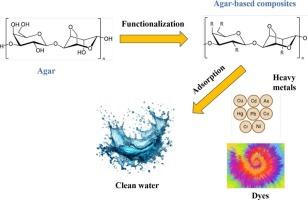琼脂基吸附剂在废水中染料和重金属去除中的应用:现状、挑战和未来展望
IF 5.1
3区 工程技术
Q1 CHEMISTRY, APPLIED
引用次数: 0
摘要
有毒染料和重金属的过量排放已成为一个重大的环境和公共卫生问题。因此,研究环境友好、低成本、高效的吸附剂已成为污水处理研究的一个重要领域。本文综述了琼脂基吸附剂对废水中染料和重金属的去除作用,强调了琼脂是一种从红藻中提取的可生物降解和可再生的多糖,富含能增强其吸附潜力的官能团。它侧重于琼脂改性的最新进展,即交联,接枝和纳米材料的复合制备,以提高其机械强度,选择性和吸附能力。综述了各种合成方法及其对污染物吸附能力的影响。尽管前景看好,但其他方面,如再生边界、水中机械不稳定性和可扩展性边界,仍然占上风。总之,本文提供了一些有用的最新进展,并强调了跨学科微生物学研究在实际废水处理中使用琼脂基吸附剂的重要性。本文章由计算机程序翻译,如有差异,请以英文原文为准。

Application of agar-based adsorbents in the removal of dyes and heavy metals from wastewater: Current advances, challenges, and future perspectives
Excessive release of toxic dyes and heavy metals into water bodies has become a significant environmental and public health issue. Therefore, research into environmentally friendly, low-cost, and efficient adsorbents has been a critical area of study in wastewater treatment. This review discusses agar-based adsorbents for the removal of dyes and heavy metals from wastewater, highlighting agar as a biodegradable and renewable polysaccharide derived from red algae, rich in functional groups that enhance its adsorption potential. It focuses on recent advancements in agar modification, i.e., cross-linking, grafting, and composite preparation using nanomaterials, to enhance its mechanical strength, selectivity, and adsorption capacity. The various methods of synthesis and their impact on the adsorption capacities of contaminants are critically reviewed. Although promising, others, such as regeneration frontiers, mechanical instability in water, and scalability boundaries, still prevail. Overall, this paper provides useful information on the latest developments and emphasizes the importance of interdisciplinary microbiology research to use agar-based adsorbents in real wastewater treatment.
求助全文
通过发布文献求助,成功后即可免费获取论文全文。
去求助
来源期刊

Reactive & Functional Polymers
工程技术-高分子科学
CiteScore
8.90
自引率
5.90%
发文量
259
审稿时长
27 days
期刊介绍:
Reactive & Functional Polymers provides a forum to disseminate original ideas, concepts and developments in the science and technology of polymers with functional groups, which impart specific chemical reactivity or physical, chemical, structural, biological, and pharmacological functionality. The scope covers organic polymers, acting for instance as reagents, catalysts, templates, ion-exchangers, selective sorbents, chelating or antimicrobial agents, drug carriers, sensors, membranes, and hydrogels. This also includes reactive cross-linkable prepolymers and high-performance thermosetting polymers, natural or degradable polymers, conducting polymers, and porous polymers.
Original research articles must contain thorough molecular and material characterization data on synthesis of the above polymers in combination with their applications. Applications include but are not limited to catalysis, water or effluent treatment, separations and recovery, electronics and information storage, energy conversion, encapsulation, or adhesion.
 求助内容:
求助内容: 应助结果提醒方式:
应助结果提醒方式:


